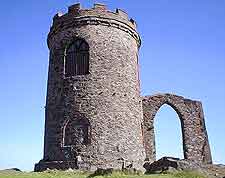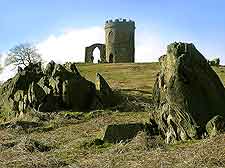Leicester History Facts and Timeline
(Leicester, Leicestershire, England)

Leicester's history stretches back at least 2,000 years. The story goes that Leicester was founded by a mythical king of the Britons known as King Leir.
At any rate, it's known that a Celtic settlement grew up on the site of the present-day city. In the Celtic language, it was known as Caerlerion, or 'city by the Leir'.
From Roman Town to Medieval City
The Roman town replaced any earlier settlements. Ratae Corieltauvorum, as it was named, was situated on higher ground above the River Leir. The Romans recognised the town's military role, and so they established a garrison town there and built defences to protect the troops within. Over time, a small town grew up, complete with a forum and basilica. Stone walls were also added.
When the Romans withdrew some 400 years later, this was still a fairly large town. Under Danish rule, it had its own mint. By the time of the Norman Conquest, 2,000 people lived here. Norman Leicester had its own castle and the Roman defences were rebuilt. In the Domesday Book of 1086, Leicester was referred to as a city. However, at some stage during the 11th century, it reverted to being a town or borough.
During the Middle Ages, Leicester was still mostly confined within its walls and these were mainly peaceful times. The market town had a strong Merchant Guild and the church was central to town life. Prosperity was in the hands of a few, namely the town's feudal landlords and Leicester Abbey, which was a major landowner.

From the 16th to 18th Century
The 16th and 17th centuries brought a great deal of change to the history of Leicester. In 1589, Queen Elizabeth I granted the town its first Charter of incorporation. This led to the growing independence of the town and the diminishing role of the previously powerful guilds.
The English Civil War divided Leicester's loyalties and had a detrimental effect on the town's economy. In 1643, a Parliamentary garrison was allowed to enter the town. In 1645, Royalist forces besieged Leicester, taking control. Their success was short-lived and after just a fortnight, following the Battle of Naseby, the Parliamentarians wrested power for a final time.
An Industrial City in the Making
Leicester's transformation from market town to industrial centre began relatively early, with the rise of a multitude of small-scale family businesses for the manufacture of hosiery.
During the 19th century, however, steam power took over. Powered by coal brought by the new canal and railway, Leicester saw a huge increase in factories. They mostly produced knitwear, boots and shoes, and needed lots of people to operate the machinery. To house the extra workers, suburbs were built, particularly around West End, Highfields and Belgrave. Middle-class suburbs also sprang up on the London Road and in Clarendon Park.
In 1919, and after a great deal of public lobbying, King George V finally approved the restoration of Leicester's city status. It marked the start of a huge post-war housing estate programme. After the Second World War, there was even more pressure on space for living and working, leading to the redevelopment of large areas of the city centre and the growth of new residential areas.
 Leicester's history stretches back at least 2,000 years. The story goes that Leicester was founded by a mythical king of the Britons known as King Leir.
Leicester's history stretches back at least 2,000 years. The story goes that Leicester was founded by a mythical king of the Britons known as King Leir.